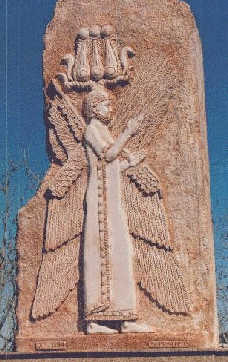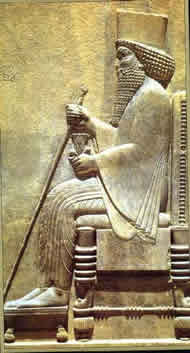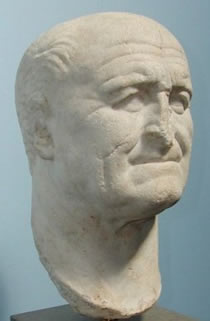"My Spirit Remains Among You"
Divine Presence in the Dust and Dirt of Our Lives
For Sunday November 7, 2010
Lectionary Readings (Revised Common Lectionary, Year C)
Haggai 1:15b–2:9 or Job 19:23–27a
Psalm 145:1–5, 17–21 or Psalm 98 or Psalm 17:1–9
2 Thessalonians 2:1–5, 13–17
Luke 20:27–38
The Old Testament reading this week comes from Haggai. Next to Obadiah, it's the shortest book in the Old Testament — barely two pages in my Bible. How did this scrap of a manuscript ever survive the ravages of time and chance so that we still read it 2,500 years later? I'm glad that it did survive, because whereas our churches and culture boast that "bigger is better" and that "size matters," Haggai says that God operates differently.
 |
King Cyrus of Persia. |
Along with Zechariah and Malachi, Haggai is one of the three "post-exilic" prophets. As their name suggests, the post-exilic prophets ministered to a demoralized remnant that had returned to the ruins of Jerusalem after seventy years of exile in Babylon. At this point in their history, the displaced Jews were an insignificant footnote to the geo-politics of the day. The headlines back then featured the fall of Babylon and the rise of Persia, the two global powers that subjugated the leftovers of what used to be the nation of Israel.
A beleaguered remnant of Jews had lived in Babylonian exile for about fifty years when the tectonic plates of history shifted. On October 13, 539 BC, Cyrus the Great of Persia (550–530 BC) conquered the Babylonian king Nabonidus in the Battle of Opis on the Tigris River near modern Baghdad. Cyrus later issued a decree in 536 BC that allowed Jews to return to Jerusalem in order to resettle their lands and to rebuild their ruined temple.
Some exiles did return, but in truth life was probably better in Babylon. The good news, of course, was the possibility of repatriation; the bad and bitter news was what the exiles found in Jerusalem.
Reconstruction of their ravaged temple had begun in 534 BC, but the effort fizzled out and ground to a halt (cf. Ezra 3:8ff, 4:24). Perhaps even back then there was a post-traumatic stress syndrome triggered by returning to the scene of a national tragedy — everywhere they looked only vivid reminders of the catastrophe of war for the losers. Maybe bitterness, resignation and demoralization undermined good intentions. It's easy to imagine that a lack of skilled labor, imperfect working conditions, insufficient building materials, and under-funded budgets stymied progress. A generation had grown up in Babylon who knew nothing of the former splendor of Solomon's temple. In fact, for some younger people who returned, their exilic experience of Judaism involved no temple at all.
 |
King Darius of Persia. |
History moved on, and in 529 BC Cyrus died. His successor, king Darius (521–485 BC), reissued the rebuilding edict about fourteen years later, and restoration of the Jerusalem temple began anew. This "second temple," as it is still called today, was finished in the year 515 BC.
As you would expect, some Jews who were still living then compared the restored second temple with Solomon's original temple; the verdict was inevitable and predictable: "Who of you is left who saw this house in its former glory? How does it look to you now? Does it not seem to you like nothing?" (Haggai 2:3). Compared to Solomon's temple, the second temple was a meager, pale imitation, and everyone knew it. That much was true. Temple rituals that had been long neglected and that were unfamiliar to a new generation led to religious defilements of all sorts (2:10ff).
But Haggai insisted that God was every bit as present in the modest second temple under the Persian ruler Darius as he had been in the extravagant temple under king Solomon of Israel, or for that matter, under the oppressive regime of king Nebuchadnezzar in Babylon when there was no temple at all. The repatriated exiles had to start over. They had to revise their judgments about the modest restoration project and what it did and did not signify about the presence of God in their community. They had to accept their meager circumstances with brutal realism, even as they worked hard to overcome them.
They also had to maintain their confidence in the word that God spoke to them through Haggai: "Be strong, all you people of the land, and work. Rebuild, for I am with you," declared the Lord Almighty. "This is what I covenanted with you when you came out of Egypt. My Spirit remains among you. Do not fear. Despite the outward circumstances, I will bless you, and the glory of the second temple will outshine the splendor of the first temple."
 |
Vespasian (AD 69-79), Roman emperor when the second temple was destroyed. |
Whether in victorious exodus out of Pharaoh's Egypt, humiliating exile to Nebuchadnezzar's pagan Babylon, or post-exilic return to the ruins of Jerusalem under the Persian rulers Cyrus and Darius — God was present among his people.
Most of us experience our share of reversal, exile, defeat, destruction, and catastrophe. Some times enemies do this to us. At other times we do this to ourselves. Often there's no apparent reason at all. Our health, our checkbooks, our jobs and families all include defeats of various sorts, whether a slight skirmish or wholesale devastation.
The outward circumstances of our lives can feel harsh beyond measure, and threaten to diminish our vision. "Does it not seem like nothing?" asked Haggai about the restored temple (2:3). Still, God speaks to us today through Haggai's ancient promise: "I am with you, do not fear, my Spirit remains among you. There can be greater glory in your lesser circumstances."
In his poem "Revival", the Welsh poet-physician Henry Vaughan (1621–1695) reminds us that even in the dust and dirt of our lives, "the lilies of God's love" still bloom.
Unfold! Unfold! Take in His light,
Who makes thy cares more short than night.
The joys which with His day-star rise
He deals to all but drowsy eyes;
And, what the men of this world miss
Some drops and dews of future bliss.Hark! How His winds have chang’d their note!
And with warm whispers call thee out;
The frosts are past, the storms are gone,
And backward life at last comes on.
The lofty groves in express joys
Reply unto the turtle’s voice;
And here in dust and dirt, O here
The lilies of His love appear!
Haggai says that God meets us where we are, not where we wish we could be, even and especially in downsized circumstances like a rebuilt temple in a ravaged Jerusalem. His Spirit moves even when we might not see or feel his presence. When we least expect it, in the dust and dirt of our lives, God says, "From this day on I will bless you" (Haggai 2:19).
For further reflection:
* Consider this historical footnote to Haggai's prophecy and reflect on the absence of the temple and the presence of God among his people.
Haggai describes how the "second temple" was finished in the year 515 BC during the reign of king Darius of Persia. This temple was enlarged and expanded by king Herod in 20 BC, but then destroyed by the Romans when they sacked Jerusalem on August 4, 70 AD to end the four-year Jewish revolt against Rome (66–70 AD). After the Romans built their own temple on the site, between 687 and 691 AD the 9th Caliph, Abd al-Malik, built a Muslim shrine on the site called the Dome of the Rock. Today the Dome of the Rock sits on the original site of the Jewish temple.
Image credits: (1) Crystalinks.com; (2) Hellenica; and (3) Antony Kamm's The Romans.





